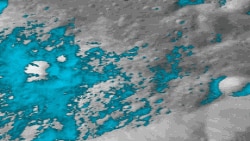An international team of scientists has reported finding evidence of water on the moon.
Researchers led by Dr. Carle Pieters of Brown University announced the results at a NASA news conference on Thursday.
"Well, the moon continues to surprise us. And that's the message that I hope you will take home with you today. Widespread water has been detected on the surface of the moon."
Using data from an American instrument flying on India's Chandrayaan satellite - and confirming data from two other spacecraft - they found water widely spread across the lunar landscape, though more toward the poles and concentrated at the surface.
Carle Pieters spoke of water, as did the other scientists, and certainly the news reports have headlined "water found on the moon." But another member of the research team, Jack Mustard, also of Brown, said it's actually unclear whether they're seeing water - a molecule with two atoms of hydrogen and one of oxygen - H20 - or hydroxyl, a chemical with only one hydrogen atom - OH.
"We can't exactly distinguish whether it is a hydroxyl - or is it water? And the simple answer is that it's difficult to make that discrimination at this point with our data," he said in an interview.
That data comes not from examining the rocks on the moon directly, but by using spectrographic analysis of the light reflected from the moon. Different chemicals have different spectrographic signatures, but those of water and hydroxyl are very similar.
The discovery comes 40 years after astronauts brought hundreds of kilos of moon rocks back to Earth, and Mustard says scientists actually saw possible hints of water in those samples.
"There were some measurements that were made that suggested that there was water or hydroxyls [in the rocks]. And some very small group of scientists advocated strongly that this was lunar water. But most dismissed it as contamination from the Earth environment, bringing the rocks from the space capsule into the laboratories, for example. There is no way that what we're looking at [now] is contamination, I'll tell you that."
Finding water, if that's what it is, probably won't be of much use to any future human visitors to the Moon. There's not much of it in any one place. One ton of rock might yield just a liter or so of water. But it may be an additional clue as scientists try to work out how the moon and the planets were formed. Did the water arise from geological activities in the Moon itself? Or did it come from some external source, from comets or meteors, for example?
The next evidence could come in just a couple of weeks, when a spacecraft called LCROSS will crash into a lunar crater, throwing up tons of debris. That debris will be analyzed by instruments that should be able to detect ice or water vapor.
News
Scientists Report Finding Water on Moon

<!-- IMAGE -->




